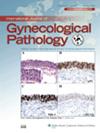叶酸受体免疫组化染色与妇科肿瘤:216 例病例的初步经验
摘要
叶酸受体α在恶性肿瘤中被证明具有可能的肿瘤发生机制,成为潜在的治疗靶点。Mirvetuximab soravtansine是一种抗叶酸受体α单克隆抗体,其FOLR1-2.1免疫组化生物标志物已获批准。在获得 IRB 批准后,我们对妇科病理病例进行了回顾性审查,以确定本机构在 9 个月内进行过 FOLR1 免疫组化 (IHC) 分析的病例,作为治疗资格临床护理的一部分。收集的临床数据包括患者的年龄、肿瘤组织型、肿瘤分级、原发肿瘤部位、FIGO 分期、复发/进展日期以及使用米韦单抗治疗的情况。记录的 FOLR1 IHC 数据包括标本获取日期、IHC 进行日期、检测部位、病例类型、肿瘤染色百分比和强度。根据目前的建议(75%,2-3+强度),病例被视为阳性或阴性。共鉴定出 216 例病例。患者年龄从 25 岁到 83 岁不等(中位数:59 岁)。染色强度为 0 的有 15 例(6.9%),弱(1+)的有 8 例(3.7%),中等(2+)的有 27 例(12.5%),强(3+)的有 27 例(12.5%),弱到中等(1-2+)的有 15 例(6.9%),中等到强(2-3+)的有 99 例(45.8%);未提供强度的有 25 例(11.6%)。肿瘤染色的百分比从 0 到 100 不等,中位数为 60。98 例(45.4%)的 IHC 结果为阳性,118 例(54.6%)为阴性。按组织类型划分,17 例低度浆液性癌中有 5 例(29.4%)呈阳性,162 例高级别浆液性癌中有 88 例(54.3%)呈阳性,5 例癌肉瘤中有 3 例(60%)呈阳性,6 例混合型癌中有 2 例(33.3%)呈阳性。没有一例透明细胞癌、子宫内膜样癌、Mullerian CA NOS、浆液性边界癌、粘液腺癌或颗粒细胞瘤呈阳性。192例(88.9%)患者的原发部位为输卵管,8例(3.7%)患者的原发部位为腹膜,3例(1.4%)患者的原发部位为子宫,13例(6%)患者的原发部位不明。按进行免疫组化染色的部位划分:96 个病例中有 53 个(55.2%)原发部位阳性,41 个病例中有 23 个(52.1%)诊断时/清扫时转移部位阳性,79 个病例中有 22 个(27.8%)转移/复发病例阳性。在比较这些部位的阳性率时,存在统计学意义上的显著相关性(P = 0.0004)。对高级别浆液性癌的生存数据进行了研究,发现阳性和阴性病例的总生存期(P = 0.622)或无进展生存期(P = 0.711)差异无统计学意义。活检标本阳性病例有 17 例(25%),阴性病例有 51 例(75%);切除标本阳性病例有 81 例(54.7%),阴性病例有 67 例(45.3%),差异有统计学意义(P < 0.0001)。病例Folate receptor alpha has been shown to have possible mechanisms of tumorigenesis in malignancies, becoming a potential target for therapy. Mirvetuximab soravtansine is an antifolate receptor alpha monoclonal antibody, with an approved FOLR1-2.1 immunohistochemical biomarker. After IRB approval, a retrospective review of gynecologic pathology cases was performed to identify cases in which FOLR1 immunohistochemistry (IHC) was performed at our institution over a period of 9 months as part of clinical care for therapy eligibility. Clinical data collected included patients' age, tumor histotype, tumor grade, primary tumor site, FIGO stage, dates of recurrence/progression, and use of mirvetuximab therapy. FOLR1 IHC data were recorded, including the date specimen obtained, date IHC was performed, site tested, case type, percentage tumor staining, and intensity. Cases were deemed positive or negative according to current recommendations (75%, 2-3+intensity). Two hundred sixteen cases were identified. Patient ages ranged from 25 to 83 years old (median: 59 yr). Staining intensity was reported as 0 in 15 (6.9%) cases, weak (1+) in 8 (3.7%), moderate (2+) in 27 (12.5%), strong (3+) in 27 (12.5%), weak-to-moderate (1-2+) in 15 (6.9%), and moderate-to-strong (2-3+) in 99 (45.8%); intensity was not provided in 25 (11.6%). Percentage of tumor staining ranged from 0 to 100, with a median of 60. The IHC was overall deemed positive in 98 (45.4%) cases and negative in 118 (54.6%). By histotype, 5 of 17 (29.4%) low-grade serous carcinomas, 88 of 162 (54.3%) high-grade serous carcinomas, 3 of 5 (60%) of carcinosarcomas, and 2 of 6 (33.3%) of mixed carcinomas were positive. No case of clear cell CA, endometrioid CA, Mullerian CA NOS, serous borderline, mucinous CA, or granulosa cell tumor was positive. The primary site of disease was tubo-ovarian in 192 (88.9%) cases, peritoneal in 8 (3.7%) cases, uterine in 3 (1.4%) cases, and unknown in 13 (6%) cases. By site on which immunohistochemical stain was performed: primary site positive in 53 of 96 (55.2%) cases, metastatic site at time of diagnosis/debulking positive in 23 of 41 (52.1%) cases, and metastatic/recurrent cases positive in 22 of 79 (27.8%) cases. There was a statistically significant correlation when comparing the positivity rates between these sites ( P = 0.0004). Survival data were examined with high-grade serous carcinoma, with no statistically significant difference between positive and negative cases in overall survival ( P = 0.622) or progression-free survival ( P = 0.711). Biopsy specimens were positive in 17 (25%) cases, while negative in 51 (75%), whereas resection specimens were positive in 81 (54.7%) and negative in 67 (45.3%), a statistically significant difference ( P < 0.0001). Cases that were <19 months old had 38 (36.2%) positive and 67 (63.8%) negative, compared with cases ≥19 months old that had 60 (54.1%) positive and 51 (45.9%) negative, a statistically significant difference ( P = 0.0084). Significant differences in FOLR1 staining were noted between histotypes, age of the specimen, type of case tested, and site of disease tested. Further testing is needed to help determine the best tissue to be utilized for this new biomarker.

 求助内容:
求助内容: 应助结果提醒方式:
应助结果提醒方式:


